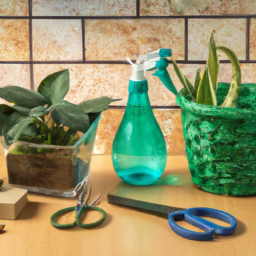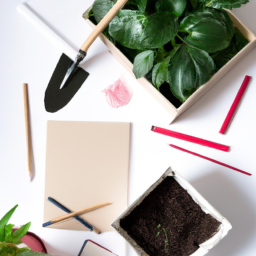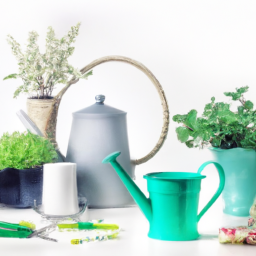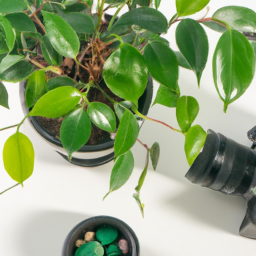
Hey there plant lovers! Are you ready to transform your indoor space into a lush oasis? Look no further because today we are diving into the wonderful world of cultivating your indoor green space with our step-by-step guide. Whether you’re a seasoned plant parent or just starting out, this blog post is here to provide you with all the tips and tricks you need to create a thriving indoor garden. So grab your gardening gloves and let’s get started on this exciting journey of bringing nature indoors!
Choosing the Right Plants for Your Indoor Green Space
Welcome to the ultimate guide on cultivating your indoor green space! In this step-by-step guide, we will explore the essential aspects of creating a thriving indoor garden. One of the first and most important steps is choosing the right plants for your indoor space. Whether you have a small apartment or a spacious home, selecting the right plants will ensure their health and longevity.
Consider Your Indoor Environment
Before diving into the world of indoor gardening, it’s crucial to assess your indoor environment. Factors such as lighting conditions, temperature, and humidity levels will play a significant role in determining the type of plants that will thrive in your space. Take note of the amount of natural light your space receives throughout the day. Is it direct or indirect sunlight? This information will help you choose plants that are suitable for your specific lighting conditions.
Additionally, consider the temperature and humidity levels in your home. Some plants prefer warmer temperatures, while others thrive in cooler environments. If your home tends to be dry, you may need to invest in a humidifier or choose plants that can tolerate lower humidity levels. Understanding these environmental factors will narrow down your plant options and increase your chances of success.
Lastly, take into account the available space in your home. Do you have large windowsills, empty corners, or hanging hooks? Different plants have varying space requirements, so it’s essential to choose plants that can comfortably fit and grow in your available space.
Matching Plants with Your Lifestyle
Another critical factor to consider when choosing plants for your indoor green space is your lifestyle. Are you a busy individual with limited time to care for plants, or do you have more flexibility in your schedule? This consideration will help determine the level of maintenance your plants require.
If you have a hectic schedule, low-maintenance plants such as snake plants, pothos, or ZZ plants might be the ideal choice. These plants are known for their resilience and ability to thrive with minimal care. On the other hand, if you enjoy spending time tending to your plants and have a green thumb, you can opt for more demanding plants like orchids or ferns.
Additionally, think about any allergies or sensitivities you may have. Some plants release pollen or emit strong scents that can trigger allergies or irritate respiratory conditions. If you or your family members are sensitive to certain plants, it’s best to avoid them and choose hypoallergenic options instead.
Researching Plant Care Requirements
Once you have considered your indoor environment and lifestyle, it’s time to research the care requirements of potential plants. Each plant has unique needs when it comes to watering, fertilizing, and overall care.
Start by understanding the watering needs of your chosen plants. Some plants prefer to dry out between waterings, while others require consistent moisture. Overwatering or underwatering can lead to plant stress or even death, so it’s crucial to find the right balance. Research the specific watering schedule and techniques for each plant to ensure their optimal health.
In addition to watering, fertilizing is essential for providing plants with the necessary nutrients. Some plants require frequent fertilization, while others can thrive with minimal feeding. Understanding the fertilizing needs of your plants will help you establish a proper routine to keep them nourished and flourishing.
Lastly, familiarize yourself with any special care instructions for your chosen plants. Some plants may require pruning, repotting, or specific temperature and humidity conditions. By knowing these requirements in advance, you can provide the best possible care for your indoor garden.
Now that you have a solid understanding of how to choose the right plants for your indoor green space, you can confidently move forward with creating your own indoor oasis. Remember to consider your indoor environment, match plants with your lifestyle, and thoroughly research plant care requirements. Happy gardening!

Cultivating Your Indoor Green Space: A Step-by-Step Guide
2. Creating the Ideal Environment for Indoor Plants
Welcome to the second step of our comprehensive guide on cultivating your indoor green space! In this section, we will explore the crucial aspects of creating the ideal environment for your indoor plants to thrive. By understanding the specific needs of your plants and providing them with the right conditions, you can ensure their health, growth, and overall well-being. Let’s dive in!
Understanding Light Requirements
Light is one of the most vital factors for indoor plant growth. Different plants have varying light requirements, so it’s important to assess the lighting conditions in your space and choose plants accordingly.
First, consider the direction your windows face. South-facing windows receive the most direct sunlight throughout the day, making them ideal for plants that require full sun. East-facing windows receive gentle morning light, suitable for plants that prefer moderate light. West-facing windows offer afternoon sun, which can be intense, so choose plants that can tolerate higher light levels. North-facing windows provide the lowest light levels, making them suitable for low-light tolerant plants.
If natural light is limited in your space, you can supplement it with artificial lighting. LED grow lights are an excellent option as they provide the full spectrum of light required for plant growth. Place the lights at an appropriate distance from your plants to avoid burning them and ensure they receive light for around 12-16 hours per day.
Temperature and Humidity
Temperature and humidity play crucial roles in maintaining the optimal environment for your indoor plants. Most houseplants thrive in temperatures between 60-75°F (15-24°C) during the day and slightly cooler temperatures at night.
Avoid placing your plants near drafts, heating vents, or air conditioning units as sudden temperature fluctuations can stress them. Maintain a consistent temperature and avoid extreme temperature changes to ensure the well-being of your plants.
Humidity levels also impact plant health. While some plants prefer higher humidity, others can tolerate drier conditions. You can increase humidity by using a humidifier or placing a tray filled with water near your plants. Grouping plants together can also create a microclimate that increases humidity. If the air is too dry, misting your plants occasionally can provide a moisture boost.
Proper Watering Techniques
Watering your indoor plants correctly is essential to prevent overwatering or underwatering, both of which can harm your plants. The key is to understand the specific watering needs of each plant and adjust accordingly.
Before watering, check the moisture level of the soil by inserting your finger about an inch deep. If it feels dry, it’s time to water. Use room temperature water and water thoroughly until it drains out of the bottom of the pot. This ensures that the entire root system receives moisture.
Avoid leaving your plants sitting in standing water, as it can lead to root rot. Allow the soil to dry out slightly between waterings, as most indoor plants prefer moist but not soggy soil. However, some plants, like succulents, prefer drier conditions, so adjust your watering schedule accordingly.
Factors such as pot size, plant size, and environmental conditions can also affect watering frequency. Observing your plants and monitoring their response to watering will help you develop a watering routine that suits their needs.
Remember, it’s better to underwater than overwater. If in doubt, it’s best to err on the side of caution and water less frequently.
Creating the ideal environment for your indoor plants involves understanding their light requirements, maintaining optimal temperature and humidity levels, and mastering proper watering techniques. By providing your plants with the right conditions, you are setting them up for success and ensuring their overall well-being. Stay tuned for the next step in our guide, where we will explore the importance of choosing the right potting mix and containers for your indoor plants.

Essential Care and Maintenance Tips for Your Indoor Green Space
Creating a thriving indoor green space requires more than just placing a few plants around your home. To ensure the health and vitality of your indoor plants, it’s essential to provide them with proper care and maintenance. In this guide, we will walk you through the step-by-step process of cultivating your indoor green space, from choosing the right plants to providing them with the necessary care they need to thrive.
Choosing the Right Plants
The first step in cultivating your indoor green space is selecting the right plants for your environment. Consider factors such as lighting conditions, temperature, and humidity levels when choosing your plants. Some plants thrive in bright, direct sunlight, while others prefer indirect or low light conditions. Similarly, certain plants prefer warmer temperatures, while others can tolerate cooler environments.
When selecting plants, also consider the space available in your home. Some plants, like tall palms or ficus trees, require ample space to grow and spread their leaves. On the other hand, smaller plants like succulents or ferns are perfect for smaller spaces or tabletop displays.
Lastly, take into account your own level of experience and commitment to plant care. Some plants require more attention and care than others. If you’re a beginner, it’s best to start with low-maintenance plants that are more forgiving of occasional neglect.
Providing Adequate Lighting
Light is one of the most crucial factors in the growth and development of indoor plants. Most plants require a balance of light to carry out photosynthesis, the process by which they convert light energy into chemical energy. When cultivating your indoor green space, it’s important to understand the lighting needs of your plants and provide them with adequate exposure.
If you have plants that require bright, direct sunlight, place them near windows that receive ample sunlight throughout the day. South-facing windows usually provide the brightest light, while east or west-facing windows offer moderate light levels. If your home lacks natural light, you can also use artificial grow lights to supplement the lighting needs of your plants.
On the other hand, if you have plants that prefer indirect or low light conditions, avoid placing them in direct sunlight as it can scorch their leaves. Instead, position them near windows with sheer curtains or in areas of your home that receive filtered or indirect light.
Watering and Humidity
Proper watering is essential for the health and survival of your indoor plants. Overwatering or underwatering can lead to root rot or dehydration, both of which can be detrimental to your plants. The frequency and amount of water your plants need depend on various factors, including the type of plant, its size, and the environmental conditions in your home.
Before watering your plants, always check the moisture level of the soil. Stick your finger about an inch deep into the soil—if it feels dry, it’s time to water. However, if it still feels moist, hold off on watering for a few more days. It’s important to note that different plants have different water requirements, so it’s essential to research the specific needs of each plant in your indoor green space.
In addition to watering, maintaining proper humidity levels is also crucial for the well-being of your indoor plants. Most indoor plants prefer moderate to high humidity levels, which can be challenging to achieve, especially during dry winter months. To increase humidity, you can use a humidifier, place a tray of water near your plants, or group them together to create a microclimate.
However, be cautious not to create excessive humidity, as it can lead to fungal diseases or other issues. Regularly monitor the humidity levels in your home and adjust accordingly to provide the optimal conditions for your indoor green space.
Fertilizing and Pruning
While indoor plants can survive without fertilization, providing them with proper nutrients can promote healthier growth and vibrant foliage. Fertilizers supply essential nutrients like nitrogen, phosphorus, and potassium, which are necessary for plant growth and development. However, it’s important to use the right type and amount of fertilizer, as excessive fertilization can lead to nutrient burn or damage to the roots.
Before fertilizing your plants, read the instructions on the fertilizer package carefully. Different plants have different nutrient requirements, and some may require specific formulations. Generally, it’s best to fertilize your indoor plants during their active growth period, typically in spring and summer, and reduce or stop fertilization during the dormant period in fall and winter.
In addition to fertilizing, regular pruning is essential to maintain the shape and health of your indoor plants. Pruning helps remove dead or diseased foliage, encourages new growth, and prevents overcrowding. Use clean and sharp pruning shears or scissors to make clean cuts, and always sanitize your tools between plants to prevent the spread of diseases.
When pruning, be mindful of the growth habits of your plants. Some plants, like succulents, require minimal pruning, while others, like vining plants, may need more frequent trimming to prevent them from becoming unruly.
In conclusion, cultivating an indoor green space is a rewarding and fulfilling endeavor. By following these essential care and maintenance tips, you can create a thriving indoor oasis that brings beauty and tranquility to your home. Remember to choose the right plants, provide adequate lighting, water and maintain proper humidity levels, and fertilize and prune your plants as needed. With patience, dedication, and a little bit of green thumb, you’ll be well on your way to enjoying a lush and vibrant indoor green space.
Key Takeaways of this article
So, you’ve decided to bring the outdoors in and create your very own indoor green space. Congratulations! Cultivating plants indoors not only adds a touch of nature to your living space but also offers numerous benefits for your overall well-being. From purifying the air to reducing stress levels, indoor plants are a great addition to any home or office. But where do you start? Don’t worry, we’ve got you covered with this step-by-step guide to help you create and maintain your own thriving indoor green space.
First things first, consider the lighting in your space. Different plants have different light requirements, so it’s crucial to choose plants that will thrive in your specific environment. Take note of the natural light that enters the room and select plants accordingly. Next, think about the size and style of your indoor green space. Whether you opt for a few potted plants scattered around the room or a dedicated plant shelf, make sure the space complements your existing decor and allows for proper airflow. Once you’ve determined the layout, it’s time to choose your plants. Start with low-maintenance varieties if you’re new to indoor gardening, such as pothos or snake plants. As you gain confidence and experience, you can experiment with more challenging species. Remember to consider the care requirements of each plant, including watering frequency, humidity levels, and fertilization needs. With a little research and attention, you’ll be able to create a harmonious and thriving indoor green space that brings joy and tranquility to your life.
Frequently Asked Questions (FAQ):
Q1: Why should I cultivate an indoor green space?
A1: Cultivating an indoor green space has numerous benefits. Not only does it enhance the aesthetic appeal of your home, but it also improves air quality by absorbing carbon dioxide and releasing oxygen. Indoor plants have been shown to reduce stress, boost mood, and increase productivity. Additionally, they can act as natural humidifiers, reducing dryness in the air during winter months.
Q2: What are some easy-to-care-for indoor plants for beginners?
A2: If you’re new to indoor gardening, there are plenty of plants that are low-maintenance and perfect for beginners. Some popular options include the pothos, snake plant, spider plant, and peace lily. These plants are known for their resilience and ability to thrive in various indoor conditions. They require minimal watering and can tolerate low light levels, making them ideal for those with limited experience or time.
Q3: How do I choose the right location for my indoor plants?
A3: When selecting a location for your indoor plants, consider their specific light requirements. Some plants thrive in bright, indirect light, while others prefer shade or low-light conditions. Observe the natural light patterns in your home and place your plants accordingly. South-facing windows generally provide the most light, while north-facing windows offer the least. East and west-facing windows offer moderate light levels. Remember to rotate your plants regularly to ensure even growth and prevent them from leaning towards the light source.
Q4: How often should I water my indoor plants?
A4: The watering frequency for indoor plants varies depending on factors such as plant type, pot size, and environmental conditions. As a general rule, it’s best to allow the top inch of soil to dry out before watering again. Overwatering can lead to root rot, while underwatering can cause wilting and stunted growth. Check the moisture level of the soil regularly by inserting your finger or a moisture meter into the soil. Adjust your watering schedule accordingly, ensuring that you provide adequate drainage for excess water.
Q5: How can I prevent common indoor plant pests?
A5: Indoor plants can sometimes attract pests like aphids, mealybugs, and spider mites. To prevent infestations, regularly inspect your plants for signs of pests, such as discolored leaves, sticky residue, or tiny insects. If you notice any issues, isolate the affected plant and treat it immediately. You can use natural remedies like neem oil, insecticidal soap, or a mixture of water and dish soap to control pests. Additionally, maintaining good plant hygiene by regularly wiping leaves, removing dead foliage, and avoiding overwatering can help prevent pest problems.
Dr. Olivia Green is a botanist with over two decades of experience in indoor plant cultivation. She holds a Ph.D. in Plant Biology and has dedicated her career to researching plant behavior in controlled environments. Dr. Green is passionate about helping plant enthusiasts master the art of indoor gardening through her extensive knowledge and practical insights.


